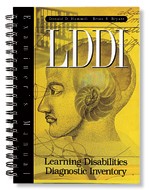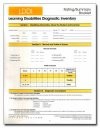Price $171.00
$149.95
Contents
The Learning Disabilities Diagnostic Inventory (LDDI) is a rating scale designed to help psychologists, diagnosticians, LD specialists, speechlanguage pathologists, and others identify (i.e., diagnose) intrinsic processing disorders and learning disabilities in students between the ages of 8-0 and 17-11. A reliable and valid norm-referenced inventory, the LDDI is composed of six independent scales‹one for each of the areas listed in the definition by the U.S. Office of Education and the National Joint Committee on Learning Disabilities: Listening, Speaking, Reading, Writing, Mathematics, and Reasoning.
Each scale contains 15 easy-to-rate items. The items were generated after an extensive review of theoretical writings and empirical studies in learning disabilities, especially the literature that focused on the neuropsychological aspects of the disabilities. The appropriateness of the behaviors represented by the items was confirmed in a survey of experts in the field and by extensive research that is reported in the manual.
The LDDI was built for the single purpose of helping professionals identify learning disabilities in individuals. It is not an ability or achievement measure (i.e., it will not tell you how well or how poorly students read, write, speak, and so forth). Instead, the LDDI will tell you the extent to which students’ skill patterns in a particular area (e.g., reading, writing) are consistent with those individuals known to have LD in that area (e.g., dyslexia, dysgraphia). Thus, using the LDDI shifts the diagnostic emphasis away from interpreting norm-referenced ability test scores and toward studying an individual’s skill patterns, especially those patterns that are indicative of people who are known to have specific learning disabilities.
Who can use the LDDI?
The examiner should be a school psychologist, educational diagnostician, speechlanguage pathologist, LD specialist, or similarly-trained professional who knows how to interpret quantitative and qualitative information and use it to diagnose specific learning disabilities. The examiner will identify the professional who is to administer the ratings; make sure the ratings are scored properly; interpret and share the results; and participate in any diagnostic, classification, or placement decisions.
The rater is the person (e.g., general educator, speechlanguage pathologist, special educator, or other qualified professional) who actually responds to the items on each scale. He or she is the professional who works closely with the individual being evaluated and who is well acquainted with his or her skills in listening, speaking, reading, writing, mathematics, and/or reasoning. Usually the rater will be the student’s teacher, remedial-education teacher, speechlanguage pathologist, or some other professional who knows the student well enough to rate the items.
Statistical Characteristics of the LDDI
The LDDI was built with the American Psychological Association’s standards for technical adequacy clearly in mind. The test was normed on 2,152 students with Learning Disabilities residing in 43 states and the District of Columbia. The demographic characteristics of the normative sample are representative of the population of students who have learning disabilities in the United States as a whole with regard to gender, race, ethnicity, urban/rural residence, family income, educational attainment of parents, and geographic distribution. The sample characteristics were stratified by age and keyed to the demographic characteristics reported in the 1996 Statistical Abstract of the United States.
The LDDI reports its scores in terms of stanines (i.e. standard scores with a mean of 5 and a standard deviation of 1.96) and percentiles. Stanines are used to (a) identify the likelihood of intrinsic processing disorders in the six areas assessed by the LDDI; and (b) conduct a profile analysis to determine the extent to which a student’s LDDI profile reflects that which is associated with learning disabilities.
Reliability
Internal consistency reliability coefficients exceed .90 for all scales. In addition, evidence for stability and interscorer reliability is also provided and coefficients are in the .80s and .90s. Thus, the LDDI can be used with confidence to yield consistent results.
Validity
Numerous validity studies were conducted to ensure that the LDDI scores have content-description, criterion-prediction, and construct-identification validity. These studies involved extensive item selection and differentiation examinations, which included confirmatory factor analysis; as well as studies that examined the LDDI’s relationship to age, academic achievement, group differentiation, gender, and ethnicity-all of which support the validity of the LDDI scores. Factor analysis research also validated the LDDI’s factor structure. These studies all provide evidence that the LDDI yields valid results that can be used with confidence to identify the presence or absence of learning disabilities in children and adolescents.
Controlling for Test Bias
The LDDI was built to minimize the effects of bias. Numerous steps were taken to detect and eliminate sources of cultural, gender, and racial bias. First, the effects of bias were controlled and minimized through the inclusion of minority groups in the normative sample. Second, the examination of reliability and validity information was presented for the different racial, ethnic, and gender groups. A particularly powerful element of content-description validity is the demonstration of excellent internal consistency reliability for the different racial, ethnic, and gender groups. Finally, the use of differential item functioning analysis was used to reduce item bias during item selection. Delta score values were used to remove items that appeared to be biased against targeted groups.

 Proud to be Canadian
Proud to be Canadian

